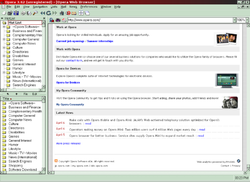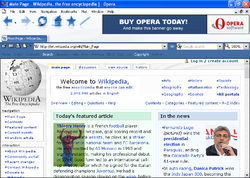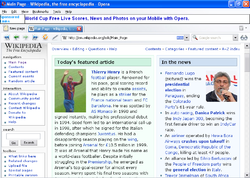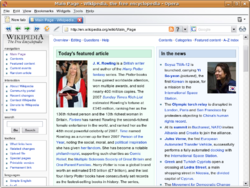- History of the Opera web browser
-
The history of the Opera web browser began in 1994 when it was started as a research project at Telenor, the largest Norwegian telecommunications company. In 1995, the project branched out into a separate company named Opera Software ASA,[1] with the first publicly available version released in 1996.[2] Since that time, Opera has undergone extensive changes and improvements, such as the relatively recent addition of built-in phishing protection.
The Opera browser was, until version 2.0, called MultiTorg Opera and was not available to the public—although online documents show it at The Third International WWW Conference in 1995.[3] It was known for its multiple document interface (MDI) and 'hotlist' (sidebar), which made browsing several pages at once much easier, as well as being the first browser to completely focus on adhering to the W3C standards.
Version 2
Version 2.0, the first public release of Opera, was released as shareware in 1996.[4][5]
Due to popular demand, Opera Software showed interest in programming its browser for alternate operating systems such as Apple Macintosh, QNX and BeOS. On October 10, 1997, they launched "Project Magic", an effort to determine who would be willing to purchase a copy of their browser in their native OS, and to properly distribute funds to develop or outsource for such operating systems.[6] On November 30, 1997 they closed voting for which operating system to develop with. Project Magic then became a news column for updates for alternate operating systems until version 4.[7]
Version 3
Opera 3 was the first version of Opera with JavaScript support,[5] but Java was still missing.[8] It was released for multiple operating systems on December 31, 1997.[9][10]
In 1998, Opera 3.5 was released, adding Cascading Style Sheets (CSS) support[5] and file upload capability.[11]
Since version 3.5, Opera has supported CSS, and Håkon Wium Lie, one of the inventors of CSS, is the CTO at Opera.[12] Up to 6.0 Opera supported most common web standards, Netscape plugins and some other recent standards such as WAP and WML for wireless devices, but its implementation of advanced ECMAScript (better known as "JavaScript") and the HTML Document Object Model was poor.
Version 3.6 was released on May 12, 1999.[13]
Version 4
On June 28, 2000,[14] Opera 4 for Windows (Elektra)[15] was released, introducing a new cross-platform core, and a new integrated e-mail client.
Version 5
Opera 5, released on December 6, 2000, was the first version which was ad-sponsored instead of having a trial period.[16] Version 5 also supported ICQ, but this was dropped from later versions.
Opera supported OS/2 for the first time, requiring WarpIN and Odin to be installed.[17]
Version 6
On November 29, 2001, Opera 6 was released with new features including Unicode support, and offering a single document interface as well as the multiple document interface allowed by previous versions.[18]
First MSN.com controversy
On October 24, 2001, Microsoft blocked users of third-party browsers, including Opera, from accessing MSN.com. Microsoft Internet Explorer users were not affected. After cries of antitrust behavior, Microsoft lifted the restrictions after two days.[19][20] However, as late as November 2001, Opera users were still locked out from some MSN.com content, despite Opera's ability to display the content if MSN.com were to serve it.[21]
Version 7
On January 28, 2003,[22] Opera 7 was released, introducing the new "Presto" layout engine, with improved CSS, client-side scripting, and Document Object Model (DOM) support. Mac OS 9 support was dropped.
Version 7.0 saw Opera undergo an extensive rewrite with the faster and more powerful Presto layout engine. The new engine brought almost full support for the HTML DOM meaning that parts of, or a whole, page can be re-rendered in response to DOM and script events.
A 2004 review in The Washington Post described Opera 7.5 as being excessively complex and difficult to use. The review also criticized the free edition's use of obtrusive advertisements when other browsers such as Mozilla and Safari were offered free of charge without including advertisements.[23]
In August 2004, Opera 7.6 began limited alpha testing. It had more advanced standards support, and introduced voice support for Opera, as well as support for Voice XML. Opera also announced a new browser for Interactive Television, which included a fit to width option Opera 8 introduced. Fit to Width is a technology that initially utilized the power of CSS, but it is now internal Opera technology. Pages are dynamically resized by making images and/or text smaller, and even removing images with specific dimensions to make it fit on any screen width, improving the experience on smaller screens dramatically. Opera 7.6 was never officially released as a final version.
On January 12, 2005, Opera Software announced that it would offer free licenses to higher education institutions,[24] a change from the previous cost of $1,000 USD for unlimited licenses. Schools that opted for the free license included Massachusetts Institute of Technology (MIT), Harvard University, University of Oxford, Georgia Institute of Technology, and Duke University. Opera was commonly criticized for having been ad-sponsored, since this was seen as a barrier to gaining market share. In the newer versions the user was allowed a choice of generic graphical banners, or text-based targeted advertisements provided by Google based upon the page being viewed. Users could pay a license fee to remove the advertisement bar.
Second MSN.com controversy
In 2003, MSN.com was configured to present Opera browsers with a style sheet used for old versions of Microsoft Internet Explorer.[25] Other browsers received either a style sheet tailored to them, or at least the latest Internet Explorer style sheet.[26] The outdated style sheet that Opera received caused Opera to move a significant amount of MSN.com's content 30 pixels to the left of where it should be, distorting the page and making it appear as though there was a bug in Opera.[27]
In response, the Opera Software company created a special "Bork" edition of Opera which displayed gibberish instead of MSN.com but not on any other web site. They did this to make a point about the necessity of a harmonious relationship between web browsers and web sites.[28]
After the complaints, Microsoft changed their servers to present the latest version of Opera, version 7, with the style sheet served to the latest version of Internet Explorer, which resolved the problem. However, Microsoft continued to serve the outdated style sheet to the older Opera 6.[26][28]
Hotmail controversy
In November 2004, Opera Software sent an electronic message to Microsoft, complaining that Opera users were sent an incomplete JavaScript file when using Hotmail. The incomplete file prevented Opera users from emptying their "Junk E-mail" folders. The Opera Software company later sent a physical letter to Microsoft. Nevertheless, as of February 11, 2005, Microsoft had neither replied to the messages nor corrected the issue.[29][30]
Version 8
On April 19, 2005, version 8.0 was released.[31] Besides supporting SVG Tiny, multimodal features and User JavaScript, the default user interface has been cleaned up and simplified. The default home page is an improved search portal.[32] The changes displeased a number of existing users since some advanced settings became hidden.[33]
Version 8.0 introduced support for Scalable Vector Graphics (SVG) 1.1 Tiny. This marked the first major web browser to natively support some form of SVG.[34] Opera has a presentation mode called Opera Show, which allows the use of a single HTML or XML document for large-screen presentations, and web browsing.
Version 8.5 was released on September 20, 2005, Opera announced that their browser would be available free of charge and without advertisements from then onwards, although the company still sells support contracts.[35] Enhancements included: automatic client-side fixing of web sites that did not render correctly, and a number of security fixes.
Version 9
Version 9.0 was the first Microsoft Windows, GNU/Linux, and BSD browser to pass the Acid2 test.[36][37] This version, released on June 20, 2006, adds XSLT and improves SVG to 1.1 Basic level.
Opera introduced Widgets, small web applications, a built-in BitTorrent client, improved content blocking and a built-in tool for creating and editing search engines. Opera is able to read MHTML and to save the web page as archives.
Version 9.1 introduced (released in 2006) fraud protection using technology from GeoTrust, a digital certificate provider, and PhishTank, an organization that tracks known phishing web sites.[38]
Version 9.2, codenamed Merlin, introduces Speed Dial, 3 X 3 small thumbnails which are shown instead of a blank page.Version 9.5, codenamed Kestrel (after the Kestrel falcon), was released to span the gap between Opera 9.2 and Opera 10.[39] It included some of the rendering improvements due to be made in Opera 10 and also aimed to provide better integration with various operating systems.[40][41][42] The first alpha build of Opera 9.5 was released on September 4, 2007. The first public beta was released on October 25, 2007,[43] and the final version was released on June 12, 2008.[44] The final release was downloaded more than 4.5 million times in the first 5 days.[45]
Opera 9.5 has improved support for Cascading Style Sheets (CSS), including many more CSS3 selectors and the CSS2
text-shadowproperty.[46][47] Support for other web standards was also improved. For example, Opera 9.5's Scalable Vector Graphics (SVG) implementation supports 93.8% of the W3C's SVG test suite,[48] and built-in support for Animated Portable Network Graphics (APNG) and MathML.[49][50] Opera 9.5 also supports high-security Extended Validation Certificates[51] and added malware protection through partnership with HauteSecure.[52]The interface has undergone a few alterations as well. It uses "Sharp" by default, a new skin designed to be more intuitive,[53] though the classic skin was still available as a user preference. Screen reader support has been added back in. Opera's mail client, Opera Mail, has been updated, with an improved indexing feature and many bugfixes.[54] Opera 9.5 also lets users save bookmarks, notes, the Personal Bar and Speed Dial settings to the Opera Link service. These preferences can then be synchronized with another Opera browser, such as a copy of Opera Mini running on a mobile phone.[55]
Alongside the new features, Opera 9.5 had new performance improvements. For example, x64-bit editions of Opera for compatible Linux and BSD operating systems.[40][56] On the other hand, SPARC Linux support has been dropped.[57]
Version 9.6 improved Opera Link with the new opportunity to sync custom search engines and typed history. Feed preview and an updated Opera Mail client were additional changes.Version 10
Version 10 (Peregrine) debuted in a first beta version on June 3, 2009 and scored 100/100 on the Acid3 test, but failed the smoothness criteria. There was also a preview build that scored 100/100, released on March 28, 2009. Among other features, it also came with speed optimizations, inline spell checking for forms, an auto update feature, HTML mail formatting, web fonts and SVG font support, alpha transparency support using the RGBA and HSLA color models, and an updated version of the Opera Dragonfly web debugger. Opera Turbo is a highlighted new feature of this version.
The official release of Opera 10 occurred on September 1, 2009. A week after release, 10 million downloads had been recorded.
The 10.5x versions (codenamed Evenes) also came with a new JavaScript engine, Carakan, and a new graphics backend, dubbed Vega, that have increased its speed measurably. Then version 10.60, which Opera Software claims to be 50% faster than Opera 10.50, which also brought up new features like Geolocation, WebM support, AVG malware protection, Speed Dial improvements, etc.
Version 11
Opera 11 (Kjevik) was released on December 16, 2010 with new features including extensions, tab stacking, visual mouse gestures, new installer (Windows only) and safety improvements to the address field. In addition, the content blocker list now can be synchronized through Opera Link.[58] It also passes the Acid3 Test as of January 22, 2011.
On 12 April 2011, Opera 11.10 (codenamed Barracuda) was released. It contains many fixes "under the hood", such as improved Turbo Mode, a plugin installation wizard and a rewritten Speed Dial. Opera 11.10 was updated to use the new Presto 2.8 Rendering Engine. [59]
On 18 May 2011, the final version of Opera 11.11 was released with improvements to security. [60] [61]
On 28 June 2011, Opera 11.50 was released. Its codename was Swordfish. It is equipped with the newest rendering engine Presto 2.9.168 featuring up to 20% faster rendering of CSS and SVG, support for HTML5 tag <time>, Session History and Navigation. It also features extensions in the Speed Dial, support for password sync in Opera Link and an updated UI. [62] On 30 August 2011 version 11.51 was released.[63]
Version 12
Opera released version 12 Pre-Alpha Build 1017 on 7 June 2011. Its code name was Wahoo.[64] Opera 12 will have hardware acceleration, support for WebGL and the new Opera Reader-feature.
Release compatibility
Operating system Latest version Mac OS 8.x 6.03[65] 9.x 7.54u2[66] Mac OS X 10.0-10.1 7.54u2[67] 10.2 8.54[68] 10.3 10.10[69] 10.4-10.5 (PowerPC) 10.63[70] 10.4 11.10[71] 10.5-10.6-10.7 11.51 Microsoft Windows Windows 3.1x 3.62[72] Windows 95/98/Me/NT 4.0 10.63[73] Windows 2000 to Windows 7 11.51 GNU/Linux Debian, Fedora, Gentoo Linux, MEPIS, Mandriva, Red Hat, Skolelinux, SUSE, and Ubuntu 11.51 FreeBSD 6.x, 7.x, 8.x 11.51 Solaris Intel and SPARC 10.11 OS/2 and eComStation 5.12 QNX 5.2.1 (stable) and 6.01b (beta) BeOS 3.62 See also
- Opera Mobile#History
- Opera Mini#History
- Nintendo DS Browser#Launch
- Internet Channel#History
- Opera Software#History
References
- ^ "Milestones". Opera Software. http://www.opera.com/company/about/milestones/. Retrieved 2007-10-30.
- ^ "Affiliated Organization of Firefox and Mozilla" (PDF). Mozilla Japan. 2006. http://www.foxkeh.com/downloads/history/history-original.pdf. Retrieved 2007-10-24.
- ^ MultiTorg Opera[dead link], retrieved on November 5, 2005
- ^ jons (1996-07-14). "Opera web browser". Google Groups. http://groups.google.com/group/comp.infosystems.www.browsers.ms-windows/msg/e3d65ea26026abc2. Retrieved 2008-02-19.
- ^ a b c Rijk (2006-02-15). "Rendering engines and code names". Tweak. Opera Software. http://my.opera.com/Rijk/blog/2006/02/15/rendering-engines-and-code-names. Retrieved 2008-02-19.
- ^ Opera Software's amazing 'Project Magic' from the Internet Archive
- ^ 'Project Magic' -- 10 February 1998 and beyond From the Internet Archive
- ^ Rakitin, Jason (27 Oktober 1997). "Review: Alternative Web browsers". Network World Fusion. Archived from the original on 5October 2001. http://web.archive.org/web/20011005005015/www.nwfusion.com/news/1997/1027browser2.html. Retrieved 26 July 2010.
- ^ Boutin, Paul (February 3, 1998). "Opera 3.0 - Browser to Beat the Band". Archived from the original on Aug 31, 2000. http://web.archive.org/web/20000831171727/http://wired.com/news/technology/0,1282,10026,00.html. Retrieved 1 February 2010.
- ^ "Opera Software - Downloading The Opera Browser". Opera Software. Archived from the original on Oct 11, 1999. http://web.archive.org/web/19991011004311/http://www.opera.com/download.html. Retrieved 1 February 2010.
- ^ Wilson, Brian. "Browser History: Opera". http://www.blooberry.com/indexdot/history/opera.htm. Retrieved 2008-02-19.
- ^ CSS: If not now, when?, Eric Meyer, June 1999, retrieved on October 25, 2005
- ^ "Opera Software Releases 3.60" (Press release). Opera Software. 1998-12-15. http://www.opera.com/press/releases/1998/12/15/. Retrieved 2008-12-10.
- ^ "Opera 4.0 for Windows Released" (Press release). Opera Software. 2000-06-27. http://www.opera.com/press/releases/2000/06/27/. Retrieved 2008-12-10.
- ^ "Opera Software Strengthens the Team" (Press release). Opera Software. 1999-11-29. http://www.opera.com/press/releases/1999/11/29/. Retrieved 2009-03-12.
- ^ "The Browser War Lights Up in Europe" (Press release). Opera Software. 2000-12-06. http://www.opera.com/press/releases/2000/12/06_2/. Retrieved 2008-12-10.
- ^ Watson, Dave (21 July 2001). "A Quick Look at Opera". The Southern California OS/2 User Group. http://www.scoug.com/os24u/2001/opera.html. Retrieved 16 August 2010.
- ^ "Opera 6.0 for Windows launched after record-breaking beta" (Press release). Opera Software. 2001-11-29. http://www.opera.com/pressreleases/en/2001/11/20011129.dml. Retrieved 2008-02-19.[dead link]
- ^ Wilcox, Joe; Sandeep Junnarkar (2001-10-26). "MSN lockout stirs antitrust rumblings". CNET. http://www.news.com/2100-1023-274998.html. Retrieved 2007-10-13.
- ^ "Microsoft Does an About-Face" (Press release). Opera Software. 2001-10-26. http://www.opera.com/pressreleases/en/2001/10/20011026.dml. Retrieved 2007-10-13.[dead link]
- ^ "Microsoft PR spin continues while browser lockout still in effect" (Press release). Opera Software. 2001-11-01. Archived from the original on 2007-12-29. http://web.archive.org/web/20071229220146/http://www.opera.com/pressreleases/en/2001/11/20011101.dml. Retrieved 2007-10-13.
- ^ "Opera 7 Ready to Rock the Web" (Press release). Opera Software. 2003-01-28. http://www.opera.com/pressreleases/en/2003/01/28/. Retrieved 2008-02-19.
- ^ Pegoraro, Rob (2004-05-23). "Some Badly Designed Features Put Opera 7.5 Out of Tune". The Washington Post. http://www.washingtonpost.com/wp-dyn/articles/A47265-2004May22.html. Retrieved 2007-10-11.
- ^ Students surf safely with Opera: Opera site license free for educational institutions, January 12, 2005, retrieved on October 25, 2005
- ^ Festa, Paul (2003-02-05). "Opera cries foul against MSN--again". CNET. http://www.news.com/2100-1023-983500.html. Retrieved 2007-10-13.
- ^ a b "Why doesn't MSN work with Opera?". Opera Software. 2003-02-20. http://people.opera.com/howcome/2003/2/msn/. Retrieved 2007-10-13.
- ^ Lettice, John (2003-02-06). "MSN deliberately breaks Opera's browser, claims company". The Register. http://www.theregister.co.uk/2003/02/06/msn_deliberately_breaks_operas_browser/. Retrieved 2007-10-13.
- ^ a b "Opera releases "Bork" edition" (Press release). Opera Software. 2003-02-14. http://www.opera.com/pressreleases/en/2003/02/14/. Retrieved 2007-10-13.
- ^ Lie, Håkon Wium (2005-02-11). "Why Opera users can't purge spam in Hotmail". Opera Software. http://people.opera.com/howcome/2005/msft/02-hotmail.html. Retrieved 2007-12-24.
- ^ "Opera to MS: Get real about interoperability, Mr Gates". The Register. 2005-02-11. http://www.theregister.co.uk/2005/02/11/hakon_on_ms_interroperability/. Retrieved 2007-12-24.
- ^ "Speed, Security and Simplicity: Opera 8 Web Browser Released Today" (Press release). Opera Software. 2005-04-19. http://www.opera.com/pressreleases/en/2005/04/19/. Retrieved 2008-02-19.
- ^ Opera search portal, retrieved on October 25, 2005
- ^ Get back old preferences dialog, retrieved on October 25, 2005
- ^ "Opera Adds SVG Tiny Support to Desktop Browser". svg.org. http://svg.org/story/2005/3/16/152318/005. Retrieved 2006-09-12.
- ^ Feel Free: Opera Eliminates Ad Banner and Licensing Fee, retrieved on October 25, 2005
- ^ "Widgets, BitTorrent, content blocking: Introducing Opera 9 Beta" (Press release). Opera Software. 2006-04-20. http://www.opera.com/pressreleases/en/2006/04/20/. Retrieved 2008-05-10.
- ^ "Changelog for Opera 9.0 Beta 1 for Windows". Opera Software. 2006-04-20. http://www.opera.com/docs/changelogs/windows/900b1/. Retrieved 2008-05-10.
- ^ Goldman, Daniel (2006-12-18). "Opera 9.1 is out with Fraud Protection". Opera Watch. http://operawatch.com/news/2006/12/opera-91-is-out-with-fraud-protection.html. Retrieved 2007-10-11.
- ^ Borg, Johan (2007-02-16). "Opera code names uncovered". Opera Software. http://my.opera.com/desktopteam/blog/show.dml/759403. Retrieved 2007-10-23.
- ^ a b Altman, Tim (2007-08-31). "Focus Areas during Kestrel Development". http://my.opera.com/desktopteam/blog/2007/08/31/focus-areas-during-kestrel-development. Retrieved 2007-10-23.
- ^ Kleinhout, Huib (2007-06-22). "Kestrel is coming!". Opera Software. http://my.opera.com/desktopteam/blog/kestrel-is-coming. Retrieved 2007-10-23.
- ^ Vollan, Per Arne (2007-07-19). "Macification". Opera Software. http://my.opera.com/desktopteam/blog/2007/07/19/macification. Retrieved 2007-10-23.
- ^ Kleinhout, Huib (2007-10-25). "Opera 9.5 beta released". Opera Software. http://my.opera.com/desktopteam/blog/2007/10/25/opera-9-5-beta-released. Retrieved 2007-10-25.
- ^ "Opera redefines Web browsing yet again". Opera Software. 2008-06-12. http://www.opera.com/pressreleases/en/2008/06/12/. Retrieved 2008-06-12.
- ^ "Opera achieves more than 4.5 million downloads for latest browser version". Opera Software. 2008-06-17. Archived from the original on 2008-06-19. http://web.archive.org/web/20080619010204/http://www.opera.com/pressreleases/en/2008/06/17-2/. Retrieved 2008-06-18.
- ^ Altman, Tim (2007-02-26). "Tim's Opera Bits v5.0". opera journal. http://weblog.timaltman.com/node/856. Retrieved 2007-10-23.
- ^ "Changelog for Opera 9.50 Alpha 1 for Windows". Opera Software. 2007-09-04. http://snapshot.opera.com/windows/w950a1.html. Retrieved 2007-10-23.
- ^ Schiller, Jeff (2007-09-04). "Welcome To CodeDread 1.1". http://codedread.com/svg-support.php. Retrieved 2007-10-23.
- ^ Minchinton, Adam (2007-09-14). "Post-Alpha Opera 9.5 Release". Opera Software. http://my.opera.com/desktopteam/blog/2007/09/14/opera-9-5-build. Retrieved 2007-10-23.
- ^ McCathieNevile, Charles (2007-09-27). "Can Kestrels do Math? MathML support in Opera Kestrel". Opera Software. http://dev.opera.com/articles/view/can-kestrels-do-math-mathml-support-in/. Retrieved 2007-10-23.
- ^ Pettersen, Yngve Nysæter (2007-06-19). "A first look at EV in Opera". Implementer's notes. Opera Software. http://my.opera.com/yngve/blog/show.dml/1095339. Retrieved 2007-11-08.
- ^ Opera and Haute Secure partner to protect consumers from next-generation Web-based threats
- ^ Borg, Johan (2008-06-05). "Looking Sharp". http://my.opera.com/desktopteam/blog/2008/06/05/looking-sharp.
- ^ Altman, Tim (2007-02-26). "Tim's Opera Bits v5.0". Tim's blog. http://weblog.timaltman.com/node/856. Retrieved 2007-10-25.
- ^ "Opera Link". Opera Software. http://www.opera.com/products/link/. Retrieved 2007-10-25.
- ^ "Index of /unix/snapshot-1662/x86_64-linux". Opera Software. Archived from the original on 2007-12-23. http://web.archive.org/web/20071223202707/http://snapshot.opera.com/unix/snapshot-1662/x86_64-linux/. Retrieved 2007-11-11.
- ^ "Opera 9.5 for Linux changelog". Opera Software. http://www.opera.com/docs/changelogs/linux/950/. Retrieved 2007-06-13.
- ^ "Are you ready for Opera 11?". Opera Desktop Team. Opera Software. December 16, 2010. http://www.opera.com/press/releases/2010/12/16/. Retrieved December 16, 2010.
- ^ http://www.opera.com/docs/changelogs/windows/1110/
- ^ http://news.softpedia.com/news/Download-Opera-11-11-201081.shtml
- ^ http://www.softpedia.com/progChangelog/Opera-for-Windows-without-Java-Changelog-7027.html
- ^ http://www.opera.com/docs/changelogs/windows/1150/
- ^ http://my.opera.com/desktopteam/blog/2011/08/30/opera-11-51-released
- ^ http://my.opera.com/desktopteam/blog/2011/07/07/introducing-opera-wahoo
- ^ Opera 6.03 for Mac OS 8
- ^ 7.54u2 for Mac OS 9
- ^ 7.54u2 for Mac OS 10.0-10.1
- ^ Opera 8.54 for Mac OS 10.2
- ^ Opera 10.10 for Panther
- ^ Opera 10.63 for PowerPC Macs
- ^ Opera 11.10 for Tiger (Intel Macs)
- ^ Opera 3.62 for Windows 3.1
- ^ Opera 10.63 (Classic Installer)
External links
- Opera browser version history
- Version history
- Opera Changelogs
- evolt.org - Browser Archive
- Download archive of old versions
Opera Companies 
Software Opera (History · Features · Opera 10 · Opera Mail) · Opera Dragonfly · Opera Mobile · Opera Mini · Nintendo DS & DSi Browser · Internet ChannelTechnology Websites Related software Notable individuals Categories:- Opera Software
- History of web browsers
Wikimedia Foundation. 2010.








